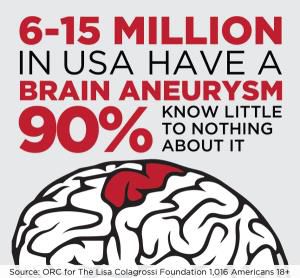(StatePoint) Ninety percent of Americans can’t fully identify what a brain aneurysm is, according to a recent survey conducted by The Lisa Colagrassi Foundation (TLCF), yet, ruptures occur every 18 minutes. What’s more, 30 percent of Americans mistakenly believe there is nothing you can do about them.
However, experts reinforce that brain aneurysms are treatable, and knowing the signs, symptoms and risk factors saves lives.
Click Here to Enlarge Infographic.
“Because Americans aren’t informed to recognize all the signs, they aren’t getting to the emergency room early enough, which translates to lives lost or diminished by life-long disabilities,” says Dr. Howard Riina a leading neurosurgeon at New York University Langone Medical Center, and head of the medical board for TLCF, the first organization devoted to brain aneurysm awareness and education.
Women and African-Americans are more likely to suffer from brain aneurysms. Warning signs come on suddenly and include severe headache, light sensitivity, neck stiffness, sharp pain behind or above one eye or drooping eyelid, blurred or double vision, numbness and tingling in the face, loss of consciousness, confusion, seizure, hearing a loud “boom” noise, nausea and vomiting. To learn more about risk factors and symptoms, visit tlcfound.org.
Todd Crawford, who founded TLCF after his wife Lisa, an ABC News television journalist died of a brain aneurysm, says more information could have saved his wife’s life.
“If we had known the signs, we could have recognized Lisa’s onset of the worst headache of her life as one of the classic warning signs of a brain aneurysm,” says Crawford.

